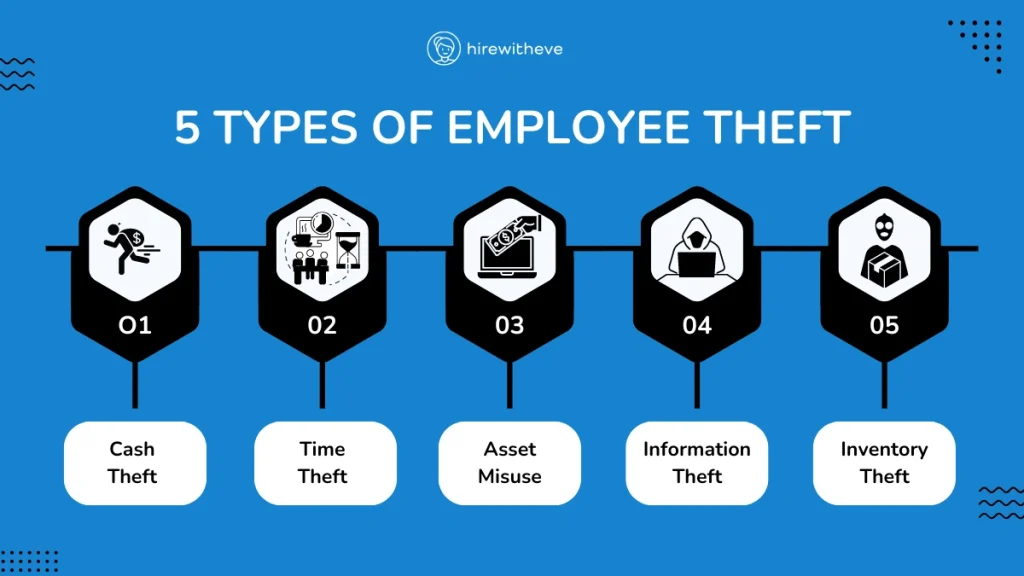What Are the 5 Types of Employee Theft?

Employee theft is a significant issue that companies of all sizes face, affecting the bottom line, workplace culture, and employee trust. As a talent acquisition specialist or HR manager, understanding the various types of employee theft can help you take preventive measures when hiring and managing staff.
This blog explores the 5 types of employee theft, offering insights into how they occur and how you can mitigate the risk of them happening within your organization.
By understanding the types of employee theft, talent acquisition specialists and HR managers can better tailor their hiring strategies to bring in honest, trustworthy employees and put safeguards in place to protect their organizations.
What is Employee Theft?
Employee theft refers to any form of stealing, fraud, or misuse of a company’s resources by its employees. It can occur in various ways, ranging from the theft of physical goods like inventory and cash to more subtle forms such as time theft or the misuse of company data and assets. While most people associate theft with large-scale incidents, even small, recurring acts of dishonesty can lead to significant financial losses over time.
For talent acquisition specialists and HR managers, understanding employee theft is crucial because it affects not only the company’s financial health but also workplace morale and trust. When theft occurs, it can damage the company’s reputation, disrupt operations, and lead to costly legal proceedings. Recognizing the different types of employee theft early on allows HR professionals to implement better hiring practices and internal controls, minimizing the risk of theft and ensuring a more secure work environment.
The 5 Types of Employee Theft

Cash Theft
One of the most common types of employee theft is cash theft. This involves employees stealing money directly from their workplace, whether through embezzlement, skimming cash transactions, or manipulating refunds. Cash theft is often easier to detect in retail environments or businesses handling large amounts of cash. However, it can still occur in any setting where employees have access to financial accounts or petty cash funds.
A 2020 study by the Association of Certified Fraud Examiners (ACFE) found that cash theft accounts for nearly 20% of occupational fraud cases globally. Businesses must implement regular audits and stringent cash-handling policies to minimize risks. Talent acquisition teams should assess candidates for roles with access to company funds carefully, ensuring they have a clean financial record and strong references.
Time Theft
Time theft is one of the least obvious yet most damaging types of employee theft. This occurs when employees are paid for time they haven’t worked. Common examples include buddy punching, where employees clock in or out for their absent coworkers, and spending excessive time on non-work-related activities during working hours, such as social media browsing or personal phone calls.
While time theft may seem minor, its cumulative effect can result in thousands of lost dollars for the company over time. A study by Robert Half reported that employees can spend up to 56 minutes a day on non-work-related tasks. For HR managers, monitoring time theft can be challenging, but by utilizing software that tracks employee productivity and having clear policies on time management, you can minimize this risk.
Asset Misuse
Asset misuse is another one of the overlooked types of employee theft. This involves employees using company property for personal reasons without authorization. Examples include using company vehicles for personal errands, taking office supplies for home use, or accessing and using company software for side projects. While the impact of asset misuse can range from minor to significant, it represents a clear violation of trust and company policy.
Many businesses now have formal asset management policies in place, clearly stating what constitutes acceptable use of company property. Additionally, hiring managers need to ensure candidates understand and respect these guidelines. Conducting thorough background checks and implementing proper supervision are essential in reducing the likelihood of asset misuse.
Information Theft
In today’s digital age, types of employee theft extend beyond physical assets to include sensitive data and information. Information theft occurs when employees steal intellectual property, confidential client information, or trade secrets. With many companies now handling large volumes of sensitive data, information theft has become increasingly prevalent and damaging.
A 2021 report from IBM highlighted that data breaches due to employee theft cost companies an average of $4.24 million per incident. Protecting your organization from information theft requires a combination of strict data security protocols, regular training on cybersecurity practices, and monitoring employee access to confidential information.
Inventory Theft
For companies dealing with physical products, inventory theft is a significant concern and another common type of employee theft. This involves employees taking products, raw materials, or supplies for personal use or resale. Inventory theft can range from small-scale thefts, like pocketing a few items, to large-scale operations involving organized theft rings within the company.
According to the National Association for Shoplifting Prevention, nearly 75% of inventory shortages are due to employee theft. Companies should invest in comprehensive inventory management systems, conduct regular inventory audits, and hire honest employees who have a proven track record in roles requiring product handling.
Conclusion
The types of employee theft outlined above — cash theft, time theft, asset misuse, information theft, and inventory theft — are issues that all companies must contend with. While it’s nearly impossible to eliminate all risks, taking a proactive approach in hiring, training, and monitoring employees can significantly reduce the chances of employee theft.
As a talent acquisition specialist or HR manager, you play a vital role in preventing these types of employee theft. This begins by ensuring you hire candidates who align with your company’s values and have a clean professional history. Leveraging advanced tools and platforms can aid in screening and monitoring employees more effectively.
HirewithEve.ai is the ideal platform for hiring professionals aiming to reduce the risk of employee theft. With features like skills-based assessments, remote hiring support, analytics, and insights, HirewithEve.ai helps you identify trustworthy candidates who are less likely to engage in any of the five types of employee theft. Additionally, its advanced tracking and analysis capabilities allow HR managers to stay one step ahead by identifying potential red flags before they escalate into serious issues.
By using HirewithEve.ai, companies can ensure they’re hiring the best possible candidates while protecting their assets and reducing the risks associated with the types of employee theft.





